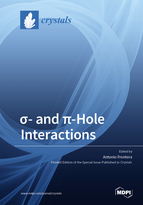σ- and π-Hole Interactions
A special issue of Crystals (ISSN 2073-4352). This special issue belongs to the section "Crystal Engineering".
Deadline for manuscript submissions: closed (31 May 2020) | Viewed by 45789
Special Issue Editor
Interests: noncovalent interactions; theoretical chemistry; DFT calculations; σ- and π-hole interactions; crystallography
Special Issues, Collections and Topics in MDPI journals
Special Issue Information
Dear Colleagues,
Noncovalent interactions are very important in many disciplines, especially in crystal growth and crystal engineering. Nowadays, we know, mostly from theoreticians, that the distribution of the electron density around covalently bonded atoms is anisotropic. Therefore, a single atom exhibits areas of higher and lower electron density, where the electrostatic potential can be negative and positive, respectively. Consequently, the positive area (σ- or π-hole) is able to form attractive interactions with any electron-rich site. After the emergence of the halogen bond (HaB), the interest in the similar behaviour of the elements of groups 13–16 and 18 from the periodic table to form analogous attractive interactions with nucleophiles, is growing exponentially. It is now well recognized that HaB and chalcogen bonds (ChB) form supramolecular synthons in their solid state. However, more experimental information is likely needed in order to extend such a statement to the elements of groups, 13, 14, and 15 acting as Lewis acids, and to be able to develop some general heuristic principles.
We invite researchers to contribute to the Special Issue on σ- and π-hole interactions, which is intended to serve as a unique multidisciplinary forum covering all aspects of noncovalent interactions involving π-block elements as electron acceptors in crystalline materials.
The potential topics include, but are not limited to, the following:
- Synthesis and growth crystals exhibiting σ- and π-hole interactions
- Crystal engineering based on σ- and π-hole interactions
- Description, analysis, and theoretical studies of supramolecular assemblies
- Structure and properties of new materials based on σ- and π-hole interactions
Prof. Dr. Antonio Frontera
Guest Editor
Manuscript Submission Information
Manuscripts should be submitted online at www.mdpi.com by registering and logging in to this website. Once you are registered, click here to go to the submission form. Manuscripts can be submitted until the deadline. All submissions that pass pre-check are peer-reviewed. Accepted papers will be published continuously in the journal (as soon as accepted) and will be listed together on the special issue website. Research articles, review articles as well as short communications are invited. For planned papers, a title and short abstract (about 100 words) can be sent to the Editorial Office for announcement on this website.
Submitted manuscripts should not have been published previously, nor be under consideration for publication elsewhere (except conference proceedings papers). All manuscripts are thoroughly refereed through a single-blind peer-review process. A guide for authors and other relevant information for submission of manuscripts is available on the Instructions for Authors page. Crystals is an international peer-reviewed open access monthly journal published by MDPI.
Please visit the Instructions for Authors page before submitting a manuscript. The Article Processing Charge (APC) for publication in this open access journal is 2600 CHF (Swiss Francs). Submitted papers should be well formatted and use good English. Authors may use MDPI's English editing service prior to publication or during author revisions.
Keywords
- halogen bonding
- chalcogen bonding
- pnicogen bonding
- tetrel bonding
- triel bonding
- σ- and π-hole interactions






